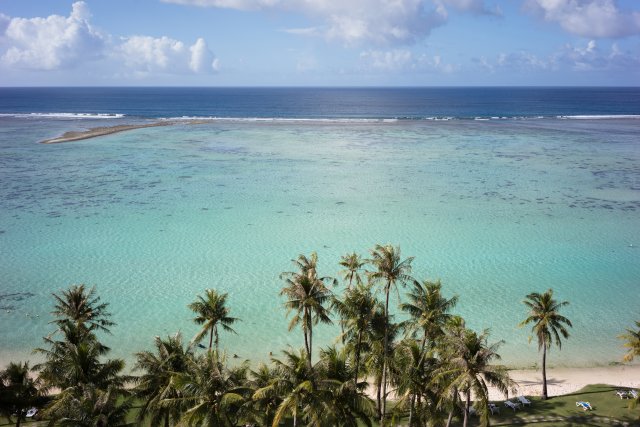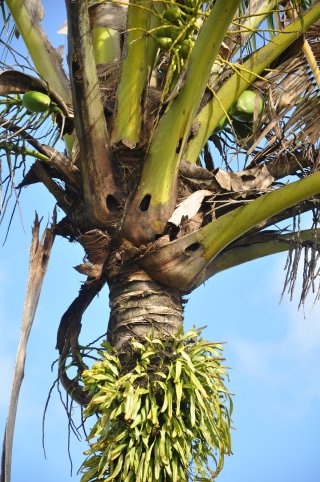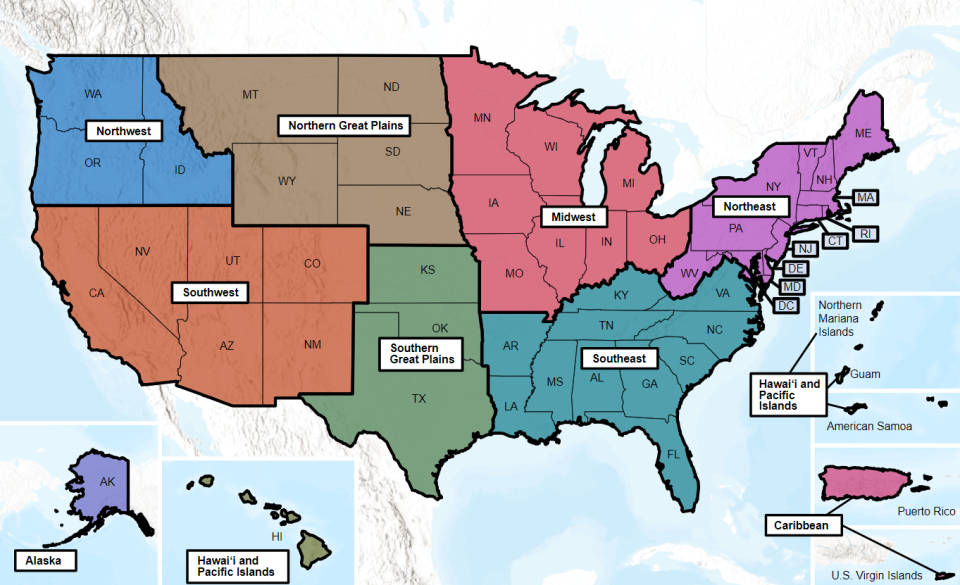Climate Change Connections: Guam (Coconut Palms)
Climate change is impacting all regions and sectors of the United States. The State and Regional Climate Change Connections resource highlights climate change connections to culturally, ecologically, or economically important features of each state and territory. The content on this page provides an illustrative example. As climate change will affect each state and territory in diverse ways, this resource only describes a small portion of these risks. For more comprehensive information about regional climate impacts, please visit the Fifth National Climate Assessment and Climate Change Impacts by Sector.
On this page:
Introduction: Coconut Palms are a Versatile and Crucial Resource

Located in the western Pacific Ocean, the United States territory of Guam is the southernmost and largest island in the Mariana Archipelago.1 As of 2020, more than 153,000 people live on Guam.2 The original inhabitants of the island are the CHamoru people who, according to archeologists, navigated to Guam from Southeast Asia in boats over 4,000 years ago.3 The CHamoru people primarily settled along the coast and utilized the ocean resources around them, relying on fish as a staple in their diet.3 They also introduced numerous plants to the island, including coconuts, rice, sugar cane, and taro.4
After their introduction to Guam, coconut palms became one of the most abundant tree species on the island.5 The CHamoru used every piece of the coconut palm, to make everything from animal feed to fishing hooks.3,6 Copra, the dried meat of the coconut, was at one point the only crop Guam exported.6 Traditionally built latte homes on Guam featured thatched roofs that were typically woven from coconut palms.7 Today, groups of CHamoru people in Guam still practice the traditional CHamoru art of palm leaf weaving.
Climate Impacts: Climate Change Could Increase Habitat Suitability for Invasive Species

The coconut palm is threatened by an invasive insect called the coconut rhinoceros beetle (Oryctes rhinoceros). First detected on Guam in 2007, the coconut rhinoceros beetle has since spread across the island.1,8 The beetles bore through the crown of the palm, leaving behind large holes at the base of the palm frond and V-shaped notches in the palm leaves.8,9 The spread of the coconut rhinoceros beetle is also encouraged by another invasive species, the brown tree snake (Boiga irregularis). The accidental introduction of the brown tree snake has been catastrophic for the native bird population on Guam, diminishing the number of birds that prey on the beetles.4,10

Climate change could amplify threats to the coconut palm and enable the spread of invasive species. Located in “Typhoon Alley,” one of the most active regions for tropical storms in the Pacific, Guam is expected to experience higher intensity tropical cyclones and typhoons due to climate change.4,11,12 Debris, such as decaying vegetation and organic materials left behind from these events, are ideal breeding grounds for adult coconut rhinoceros beetles and a suitable habitat for their larvae.4,13,14 The expansion in potential habitat area following a typhoon could allow the beetle population to increase, placing further stress on Guam’s coconut palms.15 On an island known for its beautiful beaches and scenery, further coconut palm loss could impact property values and tourism.8 The loss and damage of coconut palms could also increase beach erosion and threaten food security; it has already led to economic losses in Guam and Hawaiʻi.11
Taking Action: Protecting Coconut Palms
Addressing climate change requires reducing greenhouse gas emissions while preparing for and protecting against current and future climate impacts. Communities, public officials, and individuals in every part of the United States can continue to explore and implement climate adaptation and mitigation measures. In Guam, many stakeholders are taking collaborative steps to respond to and manage existing threats and threats amplified by climate change to coconut palms, including:
- Invasive species management. The U.S. Department of Agriculture’s (USDA’s) Animal and Plant Health Inspection Service, the U.S. Forest Service, the Guam Department of Agriculture, and the University of Guam teamed up to implement an eradication program which focuses on controlling the growth of the beetle population.4 The interagency team implements methods such as using biological control agents, monitoring and surveying breeding sites, and deploying traps.16
- Public education and outreach. Public education and outreach materials can detail best practices to limit the spread of invasive species, identify and report an infestation, and convey the importance of related research and projects as strategies for aiding adaptation measures.17 Inspecting organic material for beetle larvae and reporting sightings are also two ways the public are encouraged to help control the issue.17
To learn more about climate change impacts in Guam and the other U.S.-affiliated Pacific islands, see Chapter 30 of the Fifth National Climate Assessment.
Related Resources
- Climate Change in Guam: Indicators and Considerations for Key Sectors (Pacific Islands Regional Climate Assessment)
- Coconut Rhinoceros Beetle (USDA)
References
1 Fejeran, C. C., & Stearns Friday, K. (2023). State and private forestry fact sheet Guam 2023. U.S. Forest Service. https://apps.fs.usda.gov/nicportal/temppdf/sfs/naweb/GU_std.pdf
2 U.S. Census Bureau. (2021). 2020 census population of Guam: Census designated place (CDP) [Data set]. Retrieved November 10, 2023, from https://www2.census.gov/programs-surveys/decennial/2020/data/island-areas/guam/population-and-housing-unit-counts/guam-phc-table02.pdf
3 Mushynsky, J., McKinnon, J., Cabrera, G., & Tudela, H. (2022). The foundation of island identity: Chamorro maritime practices and resistance in the Commonwealth of the Northern Mariana Islands. AlterNative: An International Journal of Indigenous Peoples, 18(2), 299–312. https://doi.org/10.1177/11771801221084123
4 Fejeran, C. C. (2021). Guam forest action plan 2020–2030. Guam Department of Agriculture Forestry & Soil Resources Division. https://www.stateforesters.org/wp-content/uploads/2021/12/GUAM-FAP_2020to2030_20210429.pdf
5 Aguon, C. F., Quitugua, J., & Gutierrez, J. (2019). Guam wildlife action plan. Guam Division of Aquatic and Wildlife Resources. https://doag.guam.gov/wp-doag-content/uploads/2021/11/GU-DOAG-DAWR-2016-GWAP-2019-07-17.pdf
6 National Park Service. (2018). Coconut palm (trongkon niyok). War In The Pacific National Historical Park. Retrieved November 9, 2023, from https://www.nps.gov/wapa/learn/nature/coconut.htm
7 Montón-Subías, S., & Hernando Gonzalo, A. (2021). Modern colonialism and cultural continuity through material culture: An example from Guam and CHamoru plaiting. International Journal of Historical Archaeology, 26, 823–847. https://doi.org/10.1007/s10761-021-00626-3
8 Campbell, R. K. (2011). Coconut rhinoceros beetle eradication program on Guam. U.S. Department of Agriculture. https://www.aphis.usda.gov/plant_health/ea/downloads/2011/CRBGuamDecember2011.pdf
9 USDA Animal and Plant Health Inspection Service. (2024). Coconut rhinoceros beetle. Plant Pests and Diseases. Retrieved October 3, 2024, from https://www.aphis.usda.gov/plant-pests-diseases/coconut-rhinoceros-beetle
10 USDA National Invasive Species Information Center. (n.d.). Brown tree snake. Retrieved November 10, 2023, from https://www.invasivespeciesinfo.gov/terrestrial/vertebrates/brown-tree-snake
11 Frazier, A. G., Johnson, M.-V. V., Fortini, L. B., Giardina, C. P., Grecni, Z. N., Kane, H. H., Keener, V. W., King, R., MacKenzie, R. A., Nobrega-Olivera, M., Oleson, K. L. L., Shuler, C. K., Singeo, A. K., Storlazzi, C. D., Wallsgrove, R. J., & Woodworth-Jefcoats, P. A. (2023). Ch. 30. Hawaiʻi and US-Affiliated Pacific Islands. In Fifth National Climate Assessment. U.S. Global Change Research Program. https://doi.org/10.7930/NCA5.2023.CH30
12 Grecni, Z., Miles, W., King, R., Frazier, A., & Keener, V. (2020). Climate change in Guam: Indicators and considerations for key sectors (Pacific Islands Regional Climate Assessment). East West Center. https://scholarspace.manoa.hawaii.edu/items/f12cbc30-2017-4b8d-8c3f-c126c819ec7c
13 Jackson, T., Marshall, S., Atumurirava, F., & Mansfield, S. (2021). Coconut rhinoceros beetle (Oryctes rhinoceros): A manual for control and management of the pest in Pacific Island countries and territories. Pacific Community. https://agresearch.figshare.com/articles/chapter/Coconut_rhinoceros_beetle_Oryctes_rhinoceros_A_manual_for_control_and_management_of_the_pest_in_Pacific_Island_countries_and_territories/22755254
14 Hao, M., Fordjour Aidoo, O., Qian, Y., Wang, D., & Ding, F. (2022). Global potential distribution of Oryctes rhinoceros, as predicted by Boosted Regression Tree model. Global Ecology and Conservation, 37(0), 11. https://doi.org/10.1016/j.gecco.2022.e02175
15 Caasi, J. A. S., Guerrero, A. L., Yoon, K., Aquino, L. J. C., Moore, A., Oh, H., Rychtář, J., & Taylor, D. (2023). A mathematical model of invasion and control of coconut rhinoceros beetle Oryctes rhinoceros (L.) in Guam. Journal of Theoretical Biology, 570, 111525. https://doi.org/10.1016/j.jtbi.2023.111525
16 U.S. Department of the Interior. (2017). Interior provides $409,885 to Guam to mitigate infestations of the coconut rhinoceros beetle and little fire ant; protect natural resources. Retrieved November 10, 2023, from https://www.doi.gov/oia/intl/interior-provides-409885-guam-mitigate-infestations-coconut-rhinoceros-beetle-and-little-fire
17 USDA Animal and Plant Health Inspection Service. (2020). Coconut rhinoceros beetle. Plant Health. Retrieved November 10, 2023, from https://www.aphis.usda.gov/plant-pests-diseases/coconut-rhinoceros-beetle

